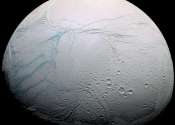Data models point to a potentially diverse metabolic menu at Enceladus
Using data from NASA's Cassini spacecraft, scientists at Southwest Research Institute (SwRI) modeled chemical processes in the subsurface ocean of Saturn's moon Enceladus. The studies indicate the possibility that a varied ...









